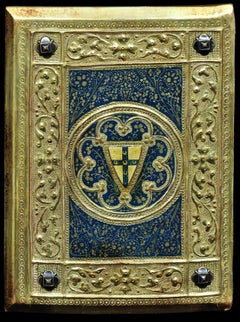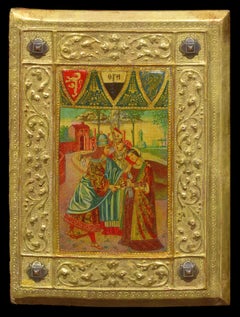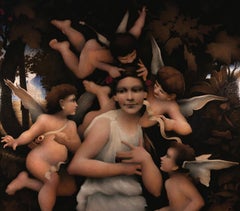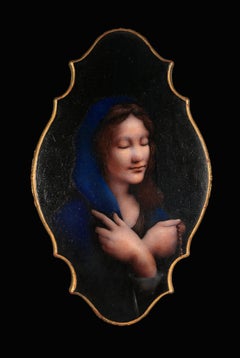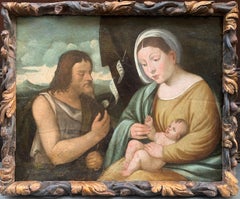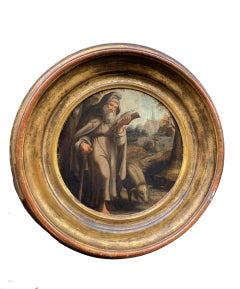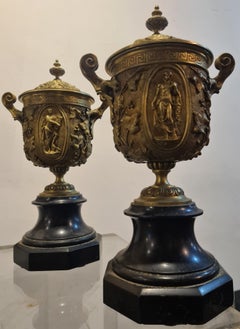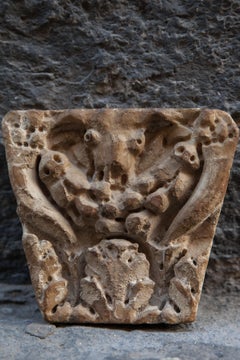Renaissance More Art
to
7
2
Overall Width
to
Overall Height
to
1
2
6
1
2,968
2,430
1,900
1,580
950
355
245
220
157
46
36
32
30
23
7
1
1
7
6
4
4
4
7
2
Style: Renaissance
Painted Wood Tavolette Book Cover Binding The Biccherna Aesthetic Siena Tuscany
Located in Sutton Poyntz, Dorset
Icilio Federico Joni.
Italian ( b.1866 - d.1946 ).
Painted Gesso, Gilt & Wood Tavolette Book Cover Binding In The Sienese Biccherna Aesthetic.
Book Cover size 11 inches x 8.1 inches ( 28cm x 20.5cm ).
Frame size 16 inches x 13 inches ( 40.5cm x 33cm ).
Available for sale; this painted gesso and gilt “tavolette” wooden book cover in the Biccherna aesthetic is by Icilio Federico Joni.
The book cover is mounted and supplied in a contemporary black Tulip Wood frame (which is shown in these photographs) which is glazed with non-reflective Tru Vue UltraVue® UV70 glass. The wooden book cover is curved and float mounted giving a wonderful 3D depth to its presentation.
The gesso and painted surfaces have benefitted from professional restoration which was performed on our instruction, supervision and approval.
This antique book cover is in very good condition, commensurate with its age.
The frame presentation is new and in excellent condition. Combined, it wants for nothing and is supplied ready to hang and display.
The story of these panels and of their artist is fascinating, and begins in 13th century Siena:
The Biccherna was the person who held the position of Magistrate of Chancellery of Finance from the 13th to the 14th century for the republic and the city of Siena, in the Tuscany region of Italy. The records of that office were very important because Siena was one of the earliest and most significant banking centres in Italy, and indeed in Europe. It became the fashion to keep banking and taxation records of the region in large books with painted leather covers. These were originally made from wood and leather. In the competition to make these ever more prestigious the bindings and panels on the front and rear of the books were painted by the major artists of the day, such as Giovanni di Paolo. Many of these mainly secular covers are displayed in the Archives of the State of Siena located in the Palazzo Piccolmini.
The Gothic Revival of the 19th century occurred partly as a reaction against the progress of industrialisation in Europe generally. It was however greatly affected by the unification of Italy in the second half of the 19th century. This led to the closure and downsizing of many religious institutions, which resulted in the dispersal of thousands of works of art dating from the Middle Ages and early Renaissance. Many aristocratic and bourgeois families struggled to pay debts or simply to make ends meet and so they sold off their private collections and family heirlooms. There was then an influx of goods into the antiques market which provided a great deal of work for Italy’s restorers and craftsmen, since many of these pieces were in need of cleaning, repair and, in keeping with the interventionist tastes of the times, radical restoration, before they could be sold on, often to foreign buyers. These early Italian works became so fashionable that demand soon outstripped supply. This in turn gave rise to a new type of artist-craftsman capable of turning out from scratch increasingly convincing reproductions, imitations and out-and-out fakes.
Siena naturally became the epicentre of this thriving cottage industry because of the extraordinary continuity there in traditional craft skills. This technical expertise had been handed down from generation to generation, and it was perhaps inevitable that a number of artists with real talent, the flair of commerce and a genuine love and understanding of antique Sienese art should adapt their skills to these new market conditions. Among these artists were Igino Gottardi, Alceo Dossena, Fulvio Corsini, Umberto Giunti...
Category
Late 19th Century Renaissance More Art
Materials
Gesso, Oil, Wood Panel
Painted Wood Tavolette Book Cover Binding The Biccherna Aesthetic Siena Tuscany
Located in Sutton Poyntz, Dorset
Icilio Federico Joni.
Italian ( b.1866 - d.1946 ).
Painted Gesso, Gilt & Wood Tavolette Book Cover Binding In The Sienese Biccherna Aesthetic.
Book Cover size 11 inches x 8.1 inches ( 28cm x 20.5cm ).
Frame size 16 inches x 13 inches ( 40.5cm x 33cm ).
Available for sale; this painted gesso and gilt “tavolette” wooden book cover in the Biccherna aesthetic is by Icilio Federico Joni.
The book cover is mounted and supplied in a contemporary black Tulip Wood frame (which is shown in these photographs) which is glazed with non-reflective Tru Vue UltraVue® UV70 glass. The wooden book cover is curved and float mounted giving a wonderful 3D depth to its presentation.
The gesso and painted surfaces have benefitted from professional restoration which was performed on our instruction, supervision and approval.
This antique book cover is in very good condition, commensurate with its age.
The frame presentation is new and in excellent condition. Combined, it wants for nothing and is supplied ready to hang and display.
The story of these panels and of their artist is fascinating, and begins in 13th century Siena:
The Biccherna was the person who held the position of Magistrate of Chancellery of Finance from the 13th to the 14th century for the republic and the city of Siena, in the Tuscany region of Italy. The records of that office were very important because Siena was one of the earliest and most significant banking centres in Italy, and indeed in Europe. It became the fashion to keep banking and taxation records of the region in large books with painted leather covers. These were originally made from wood and leather. In the competition to make these ever more prestigious the bindings and panels on the front and rear of the books were painted by the major artists of the day, such as Giovanni di Paolo. Many of these mainly secular covers are displayed in the Archives of the State of Siena located in the Palazzo Piccolmini.
The Gothic Revival of the 19th century occurred partly as a reaction against the progress of industrialisation in Europe generally. It was however greatly affected by the unification of Italy in the second half of the 19th century. This led to the closure and downsizing of many religious institutions, which resulted in the dispersal of thousands of works of art dating from the Middle Ages and early Renaissance. Many aristocratic and bourgeois families struggled to pay debts or simply to make ends meet and so they sold off their private collections and family heirlooms. There was then an influx of goods into the antiques market which provided a great deal of work for Italy’s restorers and craftsmen, since many of these pieces were in need of cleaning, repair and, in keeping with the interventionist tastes of the times, radical restoration, before they could be sold on, often to foreign buyers. These early Italian works became so fashionable that demand soon outstripped supply. This in turn gave rise to a new type of artist-craftsman capable of turning out from scratch increasingly convincing reproductions, imitations and out-and-out fakes.
Siena naturally became the epicentre of this thriving cottage industry because of the extraordinary continuity there in traditional craft skills. This technical expertise had been handed down from generation to generation, and it was perhaps inevitable that a number of artists with real talent, the flair of commerce and a genuine love and understanding of antique Sienese art should adapt their skills to these new market conditions. Among these artists were Igino Gottardi, Alceo Dossena, Fulvio Corsini, Umberto Giunti...
Category
Late 19th Century Renaissance More Art
Materials
Gesso, Oil, Tempera, Wood Panel
Coronation of Venus
Located in Mokena, IL
Coronation of Venus, 2021
Oil on Panel with 24k Gold Water-Gilded Frame, 114 x 78 inches
“Coronation of Venus,” an ornamentally enriching piece from the studio of Justas and Vilius...
Category
21st Century and Contemporary Renaissance More Art
Materials
Gold Leaf
Our Lady of Mercy
Located in Mokena, IL
Our Lady of Mercy, 2021
Oil on Panel with Carved and Gilded Frame, 8 x 14 inches
A work of spiritual devotion, Justas Varpucanskis’s “Our Lady of...
Category
21st Century and Contemporary Renaissance More Art
Materials
Gold Leaf
School of Stoics
Located in Mokena, IL
The School of Stoics brings the viewer into an airy evening discussion at an agora overlooking the Aegean Sea. Amidst the silent water and grained marble, a group of stoics debate logic, reason, and nature. Agreement and disagreement prevail in the noble gestures of their bodies. Soon you see an individual's gaze directed towards you, raising their hand, calling you to join the conversation.
Technical:
53” x 39”. Tempera on panel with 24k gold water-gilded frame. Painting and frame produced by artists Justas and Vilius Varpucanskis. This piece utilizes the "rules of craftsmanship" as outlined in Cenino Cennini's Il Libro dell'Arte. 21st century contemporary artwork that employs techniques, philosophy, and visual language of the Italian High Renaissance...
Category
21st Century and Contemporary Renaissance More Art
Materials
Gold Leaf
La Bella Attrice
Located in Mokena, IL
La Bella Attrice, 2018
Graphite and White Chalk on Toned Paper, 7.75 x 5.5 inches
Exemplifying the essence of Renaissance poise, La Bella Attrice showcases Justas Varpucanskis’s e...
Category
21st Century and Contemporary Renaissance More Art
Materials
Chalk, Graphite
Castelli Maiolica Plaque with Medieval Castle Village Italy Mediterranean Trees
Located in Austin, TX
Ceramic Plaque: 11.5 x 11.5 inches
Solid Wood Frame: 15.5 x 15.5 inches
An exquisite Castelli Maiolica plaque, featuring a richly detailed scene of the Italian Renaissance. The cera...
Category
18th Century Renaissance More Art
Materials
Ceramic, Wood
Eli
Located in Mokena, IL
Eli, 2020
Oil on Panel with Carved and Gilded Frame, 11.5 x 13.5 inches
An embodiment of Renaissance portraiture, Varpucanskis’s “Eli” is distinguished by its gentle charm and mat...
Category
21st Century and Contemporary Renaissance More Art
Materials
Gold Leaf
$17,500
Ritratto con paesaggio
Located in Mokena, IL
Riratto con Paesaggio, 2019
Oil on Panel with Frame, 11 x 14 inches
A quiet and contemplative portrait painting, "Ritratto con Paesaggio", by Justas Varpucanskis, presents a sooth...
Category
21st Century and Contemporary Renaissance More Art
Materials
Oil
Related Items
Venice. XVI century. Madonna with child with St. John. Attrib. Marco Bello.
Located in Firenze, IT
Sacred Conversation: Madonna with child with St. John with idealized landscape background with mountains.
Early XVI century.
Oil on wooden panel of Venetian conifers.
Marco Bello, attributed. (Venezia, 1470 - 1523, Udine), pupil and follower of Giovanni Bellini.
Venetian school.
Madonna with child with St. John with idealized landscape background with mountains.
Dimentions: 57cm x 68cm x 6cm
Beautiful late Renaissance frame...
Category
16th Century Renaissance More Art
Materials
Wood Panel, Oil
$4,112
H 22.45 in W 26.78 in D 2.37 in
Saint Anthony the Abbot in a Natural Landscape - Flemish School
Located in Firenze, IT
Saint Anthony The Abbot In A Natural Landscape. Flemish School, Late 16th - Early 17th Century
Technique: Oil on panel
Period: late 16th - Early 17th Century
School: Flemish
Dimensi...
Category
Early 17th Century Renaissance More Art
Materials
Oil
$1,762 Sale Price
40% Off
H 13.23 in Dm 13.23 in
18th Century Italian Oil Madonna & Child with St. John the Baptist after Raphael
Located in Cirencester, Gloucestershire
Madonna and Child with St. John the Baptist
Italian artist, 18th century, after the earlier painting by Raphael
oil on wood panel, framed in an Empire, gilt moulded frame
Framed: 23 ...
Category
18th Century Renaissance More Art
Materials
Oil
$4,209 Sale Price
30% Off
H 23 in W 22 in
Italian Renaissance Gentleman Portrait of a Tailor Antique Oil Painting
Located in Cirencester, Gloucestershire
The Tailor
Continental School, 19th century
after the earlier Renaissance work by Giovanni Battista Moroni (16th century).
oil on canvas laid over board, framed
Framed: 16 x 12 inch...
Category
19th Century Renaissance More Art
Materials
Oil
$944 Sale Price
30% Off
H 16 in W 12 in
18th Century French Oil Painting on Copper Portrait of Noble Lady
Located in Cirencester, Gloucestershire
Portrait of a Noble Lady
French School, early 1700's period
oil painting on copper, unframed
copper: 5 x 3 inches
condition: very good, minor paint fading and deteriation.
provenanc...
Category
Early 18th Century Renaissance More Art
Materials
Copper
$720 Sale Price
30% Off
H 5 in W 3 in
Circa 1500 Italian Renaissance Oil Painting on Copper St. Francis of Assisi
Located in Cirencester, Gloucestershire
St. Francis of Assisi
Italian School, circa 1500
oil paint on copper, unframed
copper: 6.75 x 10 inches
provenance: private collection, Loire Valley, France
condition: for a work tha...
Category
15th Century and Earlier Renaissance More Art
Materials
Copper
$4,185 Sale Price
30% Off
H 6.75 in W 10 in
Very Rare Renaissance Old Master Oil Painting c. 1600 Oil on Panel The Madonna
Located in Cirencester, Gloucestershire
The Virgin Madonna
Spanish Renaissance artist, circle of El Greco (1541-1614)
circa 1600
oil on wood panel, unframed
panel: 20 x 14.5 inches
Provenance: private collection, northern ...
Category
Early 17th Century Renaissance More Art
Materials
Oil
$12,894 Sale Price
30% Off
H 20 in W 14.5 in
Perin del Vaga workshop (Florence) - 16th century figure painting - Flagellation
Located in Varmo, IT
Piero di Giovanni Bonaccorsi, known as Perin del Vaga (Florence 1501 - Rome 1547), workshop of - Flagellation of Christ.
71.5 x 59.5 cm unframed, 89 x 76 cm with frame.
Oil on pane...
Category
16th Century Renaissance More Art
Materials
Panel, Oil
$5,874 Sale Price
37% Off
H 35.04 in W 29.93 in
'The Music Contest between Apollo and Pan', Renaissance Mythology, Satyr, Hermes
Located in Santa Cruz, CA
An early 17th-century Flemish School oil on copper showing the mythological contest between Apollo and Pan in which the mountain god, Tmolus, gives judgement for Apollo. Unsigned. Pa...
Category
Early 17th Century Renaissance More Art
Materials
Copper
$19,600 Sale Price
20% Off
H 19 in W 25.25 in
Portrait of an Italian Noblewoman
Located in London, GB
15th century, Italian
Circle of Antonio del Pollaiuolo (1429-1498)
Portrait of an Italian Noblewoman
Oil and tempura on poplar panel
With partial inscription: ALZETAPIN
Provenance:...
Category
15th Century and Earlier Renaissance More Art
Materials
Oil, Tempera, Wood Panel
Early 16th century. The Agony in the Garden. Southern German school.
Located in Firenze, IT
The Agony in the Garden. (Christ on the Mount of Olives).
Technique: Oil on Panel, 4 wooden boards, not parqueted.
Dim. with frame: 78cm x 67cm
Dim. without frame: 52 x 62 cm
Germa...
Category
18th Century and Earlier Renaissance More Art
Materials
Wood, Oil, Board
$9,282 Sale Price
34% Off
H 20.48 in W 24.41 in
The Virgin and Child with the Infant Baptist
By Andrea Del Sarto
Located in Henley-on-Thames, England
Florentine, mid-16th century
Circle of Tomaso D’Antonio Manzuoli, known as Maso da San Friano (1536-1571)
The Virgin and Child with the Infant Baptist
After Andrea del Sarto (1486-1...
Category
15th Century and Earlier Renaissance More Art
Materials
Oil
$11,358 Sale Price
46% Off
H 37.01 in W 34.41 in D 5.91 in
Previously Available Items
Pair of French Gilt Bronze & Marble Garniture Urns, In The Style of Barbedienne
Located in Cotignac, FR
A pair of French gilt bronze garniture urns on marble bases in the classical style. Though not signed the urns in style and quality are reminiscent of the work of Ferdinand Barbedien...
Category
Mid-19th Century Renaissance More Art
Materials
Marble, Bronze
H 12.6 in W 7.09 in D 5.52 in
Capital with ox skull: "Bucranium". 16th – 17th century
Located in Firenze, IT
Capital with ox skull: "Bucranium".
Carved marble.
16th - 17th century.
Bucranium with garlands is a decorative element that dates back to the art of Ancient Rome, later taken up by...
Category
16th Century Renaissance More Art
Materials
Marble
Florentine Figure Drawing
Located in Mokena, IL
Florentine Figure Drawing, 7x10 inches. Graphite and White Chalk on Toned Paper. Drawing by artist Justas Varpucanskis. This piece utilizes the "ru...
Category
21st Century and Contemporary Renaissance More Art
Materials
Chalk, Handmade Paper, Graphite
Renaissance Engraving, Dogs, Virgil Solis, 16th Century, Old Master, Paper Art
By Virgil Solis
Located in Greven, DE
Engraving by the artist Virgil Solis, Six dogs; standing, reclining and seated among trees.
Engraving, made by Virgil Solis.
German, c. 1530-1562.
Si...
Category
16th Century Renaissance More Art
Materials
Paper, Engraving
Ulisse Cantagalli Bottle Lustre Florence Phoenix Lapis Lazuli Blue Silver
Located in Eversholt, Bedfordshire
Ulisse Cantagalli (1839-1901) Florence, exceptional, lustre bottle, circa 1880
- Outstanding, recreation of the complex and subtle 16th century, orn...
Category
1880s Renaissance More Art
Materials
Luster, Glass
For Soul and Body
Located in New Orleans, LA
Magnificent and colorful, this enchanting Florentine work of art is not a painting, but upon closer inspection is revealed to be a superb example of the intensive art of pietre dure...
Category
Late 19th Century Renaissance More Art
Materials
Stone, Marble
Cup with Saucer Set “Red”
Located in Kansas City, MO
Cup with Saucer Set “Red”
Materials Used: Porcelain, Glaze, China Paint, Gold Luster, Decals
Year: 2018
Height: 5″
Width: 5″
Depth: 3.75″
One-of-a-kind ceramics work, completely handmade and handpainted, by Melanie Sherman. I make all of my pieces in small batches to ensure quality and uniqueness. Not one is ever like the other. This is a set of cup and saucer...
Category
2010s Renaissance More Art
Materials
Gold
Renaissance more art for sale on 1stDibs.
Find a wide variety of authentic Renaissance more art available for sale on 1stDibs. Works in this style were very popular during the 21st Century and Contemporary, but contemporary artists have continued to produce works inspired by this movement. Frequently made by artists working with Wood, and Paint and other materials, all of these pieces for sale are unique and have attracted attention over the years. Not every interior allows for large Renaissance more art, so small editions measuring 5.5 inches across are also available. Prices for more art made by famous or emerging artists can differ depending on medium, time period and other attributes. On 1stDibs, the price for these items starts at $327 and tops out at $475,000, while the average work sells for $8,024.
Recently Viewed
View AllMore Ways To Browse
Horse Painting Gold Frame
Horse Polo Paint
Hunt Double Bunnies
Hunt Etchings
Hunt Slonem Bunnies Heart
Hunt Slonem Heart Bunny
Hunt Slonem Oval
Hunt Slonem Parrots
Hunt Slonem Peace Plan
Hunt Slonem Rabbit
Irving Petlin
Isle Of Arran
Italian Fields Painting
J Harvey Painting
J Macdonald
Jack Frost Vintage
Jackie Stewart
Jaguar Xk
